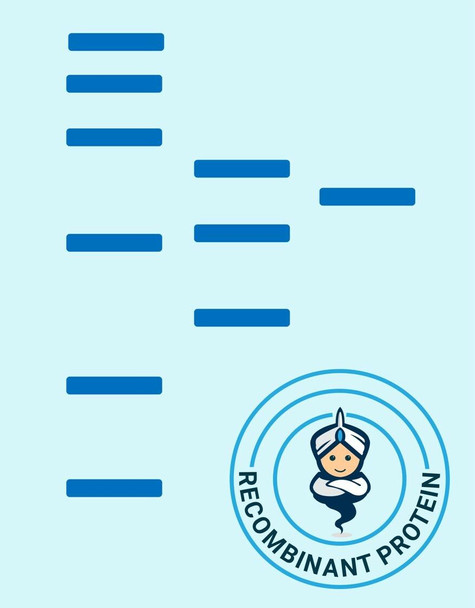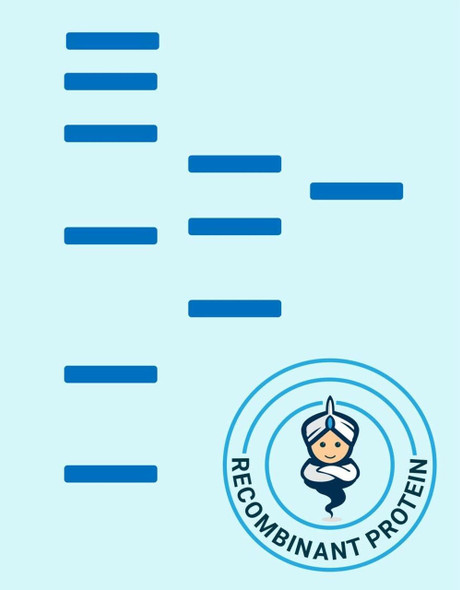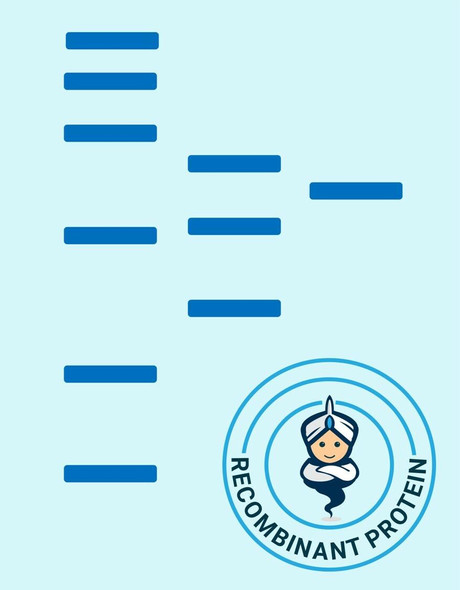Description
| Product Name: | Human ATP5F1 Recombinant Protein |
| Product Code: | RPPB2825 |
| Size: | 20µg |
| Species: | Human |
| Target: | ATP5F1 |
| Synonyms: | ATP Synthase Proton-Transporting Mitochondrial F(0) Complex Subunit B1, ATP Synthase H+ Transporting, Mitochondrial Fo Complex Subunit B Isoform 1, ATPase Subunit B, ATP Synthase B Chain Mitochondrial, Cell Proliferation-Inducing Protein 47, PIG47. |
| Source: | Escherichia Coli |
| Physical Appearance: | Sterile Filtered clear solution. |
| Formulation: | The ATP5F1 solution (0.5mg/ml) contains 20mM Tris-HCl buffer (pH 8.0), 0.4M Urea and 10% glycerol. |
| Stability: | Store at 4°C if entire vial will be used within 2-4 weeks. Store, frozen at -20°C for longer periods of time. For long term storage it is recommended to add a carrier protein (0.1% HSA or BSA).Avoid multiple freeze-thaw cycles. |
| Purity: | Greater than 80% as determined by SDS-PAGE. |
| Amino Acid Sequence: | MGSSHHHHHH SSGLVPRGSH MGSLILYALS KEIYVISAET FTALSVLGVM VYGIKKYGPF VADFADKLNE QKLAQLEEAK QASIQHIQNA IDTEKSQQAL VQKRHYLFDV QRNNIAMALE VTYRERLYRV YKEVKNRLDY HISVQNMMRR KEQEHMINWV EKHVVQSIST QQEKETIAKC IADLKLLAKK AQAQPVM |
ATP5F1 is a mitochondrial ATP synthase subunit catalyzes ATP synthesis, using an electrochemical gradient of protons all through the inner membrane for the duration of the oxidative phosphorylation. ATP synthase is comprised of two linked multi-subunit complexes: the soluble catalytic core, F1, and the membrane-spanning component, Fo, including the proton channel. The catalytic segment of mitochondrial ATP synthase contains 9 subunits: 3 alpha, 3 beta, and one unit of gamma, delta, and epsilon. The proton route is known to have 9 subunits (a, b, c, d, e, f, g, F6 and 8).
ATP5F1 Human Recombinant produced in E.coli is a single, non-glycosylated polypeptide chain containing 197 amino acids (83-256) and having a molecular mass of 22.6 kDa. ATP5F1 is fused to a 23 amino acid His-tag at N-terminus & purified by proprietary chromatographic techniques. ��
| UniProt Protein Function: | ATP5F1: Mitochondrial membrane ATP synthase (F(1)F(0) ATP synthase or Complex V) produces ATP from ADP in the presence of a proton gradient across the membrane which is generated by electron transport complexes of the respiratory chain. F-type ATPases consist of two structural domains, F(1) - containing the extramembraneous catalytic core, and F(0) - containing the membrane proton channel, linked together by a central stalk and a peripheral stalk. During catalysis, ATP synthesis in the catalytic domain of F(1) is coupled via a rotary mechanism of the central stalk subunits to proton translocation. Part of the complex F(0) domain and the peripheric stalk, which acts as a stator to hold the catalytic alpha(3)beta(3) subcomplex and subunit a/ATP6 static relative to the rotary elements. Belongs to the eukaryotic ATPase B chain family. |
| UniProt Protein Details: | Protein type:Hydrolase; Mitochondrial; EC 3.6.3.14; Energy Metabolism - oxidative phosphorylation Chromosomal Location of Human Ortholog: 1p13.2 Cellular Component: nucleoplasm; mitochondrion; membrane; mitochondrial matrix; mitochondrial inner membrane; nucleus; mitochondrial proton-transporting ATP synthase complex Molecular Function:protein binding; ATPase activity; hydrogen ion transporting ATP synthase activity, rotational mechanism; transmembrane transporter activity Biological Process: cellular metabolic process; ATP synthesis coupled proton transport; substantia nigra development; mitochondrial ATP synthesis coupled proton transport |
| NCBI Summary: | This gene encodes a subunit of mitochondrial ATP synthase. Mitochondrial ATP synthase catalyzes ATP synthesis, utilizing an electrochemical gradient of protons across the inner membrane during oxidative phosphorylation. ATP synthase is composed of two linked multi-subunit complexes: the soluble catalytic core, F1, and the membrane-spanning component, Fo, comprising the proton channel. The catalytic portion of mitochondrial ATP synthase consists of 5 different subunits (alpha, beta, gamma, delta, and epsilon) assembled with a stoichiometry of 3 alpha, 3 beta, and a single representative of the other 3. The proton channel seems to have nine subunits (a, b, c, d, e, f, g, F6 and 8). This gene encodes the b subunit of the proton channel. [provided by RefSeq, Jul 2008] |
| UniProt Code: | P24539 |
| NCBI GenInfo Identifier: | 20455474 |
| NCBI Gene ID: | 515 |
| NCBI Accession: | P24539.2 |
| UniProt Related Accession: | P24539 |
| Molecular Weight: | ~ 29kDa |
| NCBI Full Name: | ATP synthase F(0) complex subunit B1, mitochondrial |
| NCBI Synonym Full Names: | ATP synthase peripheral stalk-membrane subunit b |
| NCBI Official Symbol: | ATP5PB�� |
| NCBI Official Synonym Symbols: | PIG47; ATP5F1�� |
| NCBI Protein Information: | ATP synthase F(0) complex subunit B1, mitochondrial |
| UniProt Protein Name: | ATP synthase F(0) complex subunit B1, mitochondrial |
| UniProt Synonym Protein Names: | ATP synthase proton-transporting mitochondrial F(0) complex subunit B1; ATP synthase subunit b; ATPase subunit b |
| Protein Family: | ATP synthase F(0) complex |
| UniProt Gene Name: | ATP5F1�� |
| UniProt Entry Name: | AT5F1_HUMAN |










